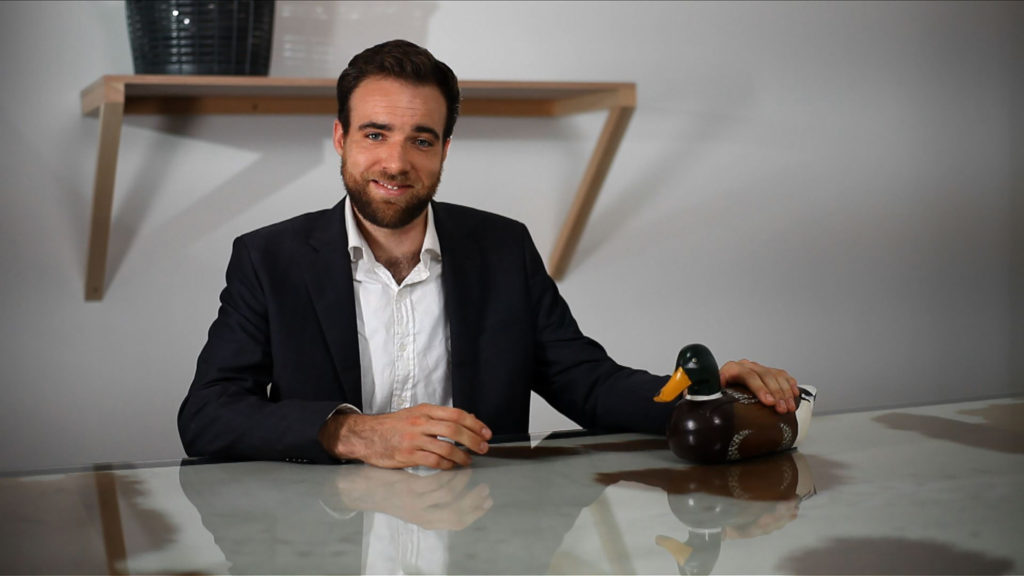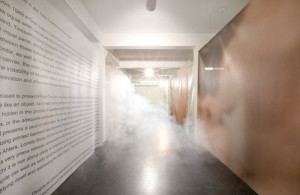I’m finally about to speak to Keren Cytter. Based between New York, Tel Aviv and Berlin, she’s an artist whose video work (most famously) seems to have long lead a critical example for the way that said media can incorporate content, imagery, style, feeling, experience and the viewer in such a broad and varied manner that often and with reliance Cytter’s extensive Vimeo account is looked at for brave video-making. The artist takes everything and makes it interesting and filmic, like a door opening, or a flatmate moving out, or the way a person is holding an open packet of butter, or a goldfish that swims across the camera, or a romantic milli-thought that someone might otherwise offer up to the atmosphere and put down to sentimentality. This in itself is a thought-process or a thing that occurs in some of Cytter’s directed scenarios too.
The artist and I had put the interview off and off again, maybe because we are both perfectionists in relation to finding the right moment to be in. There were emails which began while her recent solo exhibition of new wall-based drawings and paintings called Ocean was running was on at London’s Pilar Corrias earlier this year. Cytter gives laconic answers on when is the best time to speak, suggesting at first that 9pm my time is too late because she’s staying with her parents in Jerusalem and the Skype conversation might wake them. But then it becomes ideal as they would indeed be asleep and Cytter could talk late into the night when all around her has settled. When we finally connect she sits out on her porch, glowing from her laptop screen and we talk at length about how the artist moves from one piece of footage to the next, the depression of Europe, under-explaining decisions, friends in artworks, and somehow, present within it all, location and place, or placement.

One of the most seductive things about interviewing Cytter, who works with language so objectively inside each video, is the feeling of distance when venturing (or not) into a spoken conversation about words and their worth, their meaning and utterance. As I understand it, from seeing more and more of Cytter’s work before we speak, she uses language (i.e: French, Italian, Russian, Hebrew) as a way of producing mood and setting, or just as a way of indicating and matching together tone and effect. French, Cytter is often quoted as saying, is the language of love, and so she has her characters, or a voiceover speak it in pieces that seem right for this, like in the movies. It appears to me deeply attractive a trait in an artist, to reduce language so dedicatedly and with such elegance and impact.
In some ways it’s not about reducing language at all but suspending it, observing it, making it useful —or useable —structurally. Throughout our interview, I’m struck by the way Cytter talks and in doing so says what she means exactly. She speaks quickly, excitedly and vaguely about her videos, never pausing to qualify or tell me precisely which one she is referring to. It is so nice to hear that I don’t want to stop her mid-sentence, and the suspension and feeling that this small amount of information given is enough to let me interpret Cytter’s practice, or more specifically “the Russian movie”, she refers to repeatedly, which will be screened at her upcoming Selection exhibition at Graz’s KM-Künstlerhaus. It resonates with her work so much, although I still don’t know its title.
This reminds me of what Cytter tells me during the smaller beginnings of our dusk Skype call: “I don’t search, I surf”, she says when I clumsily ask her how and what she finds online. “I just see what comes up on my social media, like public gossip about other artists. I engage in arguments to prove my points. I click on images of Scottish people to find out why they wear skirts because I told my father [men wearing skirts] is a chauvinist act and he said: ‘so then why do Scottish people wear them’…. and then I realised, it’s fashion…”

How does being in New York, Israel or Berlin change and affect the way you work? I’m asking this for a friend who is from Tel Aviv and she’s curious.
Keren Cytter: Ah, quite a lot I think. In Israel it was really fun, I didn’t think about art at all. And then when I moved to Europe, the depression came and my work became more about line and form I think, it stopped being about fun and friends. In New York, because I’d built a lot of stuff with language, English suddenly became important so I had to focus on content and develop that a bit, which changed things. Now I’m doing something in Russian –so I’m back to European.
And you feel like the chosen and spoken language directs the tone of the work?
KC: Definitely. In Russian it will be very political —just because they [the characters] will speak Russian. And in Russian you can address hardcore stuff because of the directness in the language, like porn or violence. I have rented a proper camera for it too. I always decide on that before-hand, depending on the feeling of the work. I think where the image will be sharp, it will jar with the content of the movie so it will be harder to define it and this movie shouldn’t be easy to define. There are some that are easier to define but not this one.
Once, in Israel, for example, we filmed some stuff and set the language to be Dutch and screened it in the Netherlands and people afterwards said it was a very Dutch movie. Language makes you blind, a bit.
It does the work for you? I wonder if this is quite a beautiful thing.
KC: Yeah.
In your films, is there a love for making things you can’t see or get to?
KC: Sometimes there’s too much information but in a very delicate way, I really like it when that happens. I saw it once in Tarantino’s Kill Bill 1. There are little shots but you see how much attention there is in each one. There is a moment in my film ‘Four Seasons’ [2009] where a girl climbs the stairs while I was filming, holding sparklers and also a little disco ball right under the camera and my friend, she’s a sculptor, she helped me hold a snow machine in place. In the reflection of one of the Christmas tree balls that was in the room, you could see the snow machine that we were holding, but because I had bought the cheapest disco lights, I couldn’t turn them off so you can see them also flashing in the Christmas tree with the snow foam, which I love. I try to erase myself in the works to make them feel as though they are not mine, until it will look like someone else’s.

You have a few flat works called ‘Pattern of Violence’, which as a title, like a pattern, repeats. Does the title have anything to do with language, in that it makes things, and structures things in such a defining way?
KC: No, it was just related to the drawings. I wonder if I copied it as a phrase from somewhere or someone. Probably. But I did the drawings and it was just an attitude I had towards them. Two guys are shooting each other and it forms a pattern, it was quite simple. Now I don’t think I could do it —this pattern of violence: I don’t think I have the brain for the violence… Mmm, now you’ve made me want to do it again sometime soon…
Make a new one?
KC: Yes! Once you have a pattern, you just need to fill the inside, you know? I’m now trying to find an easy way to make drawings quickly. I saw a thing where you can order online tattoos and I thought, ‘Yes, I can just transfer drawings onto paper’.
It’s nice because once you use one, it’s gone. So it’s different to a print or some other method that allows you to do a repeat pattern. It’s more like a bee’s sting as opposed to a wasp’s. Each one is its own one.
KC: [laughs] Yeah, I had these kinds of fake tattoos and I put it on myself first. It was supposed to be for the Russian movie I’m making for Graz but it was too stressful…
Why?
KC: I don’t know. But then I found a box and put them on there and I thought, ‘These are drawings’. We’ll see —you heard it here first.
I am guilty of imagining that you are the sort of artist who hangs out with groups of friends and that work comes out. I think I have applied this fantasy to some of your films, at least. You keep mentioning ‘we’ and I presume you mean you and your friends when you make the films together, about each other, but directed by you.
KC: I mean, yes. Mostly the same scenarios are in my life and in my films. My friend in ‘Atmosphere’ [2005] really was moving out of the flat and really did just come for four days to stay, but ended up living with us for four months. She was living in the living room, which is where the film is based. It’s mostly fiction though, I just take what surrounds me. It’s not necessarily that the relationships and dynamics come into play personally, I don’t need that inspiration. It’s just that the scenario matches the idea. And, anyway, now I live by myself so it’s different.

Can you talk about rhythm?
KC: Yes, it’s very important.
It seems that if you have three or four bits of footage, they will be arranged in a rhythm that’s based on something like weight or essence, for example, the innocence of some thing. The rhythm is based on something indescribable —not necessarily the obvious things, like aesthetics or actual sounded beats.
KC: Yeah, I saw some videos by some artists and I thought to myself to criticize them. They are really false because the rhythm is just based on the beats in the music. It’s too easy and rational. It should lean on whatever content is in the work, whatever content means. It doesn’t have to mean a story.
Do you think art now has become very much about the medium only?
KC: I think there is some kind of depression or something —where nothing develops, except for technology. There is too much corruption in institutions and that leads to lots of bad scenarios where everything becomes a material and that there is no content. People produce ugly things and they don’t look any more. It’s becoming like the way I put stuff on Instagram —I don’t really care. I put cats to ease the audience. And I think it’s the same thing with art. I think it’s collapsing.
I feel maybe fiction and warmth is coming back in.
KC: I have no choice. I cannot do ugly things.**















